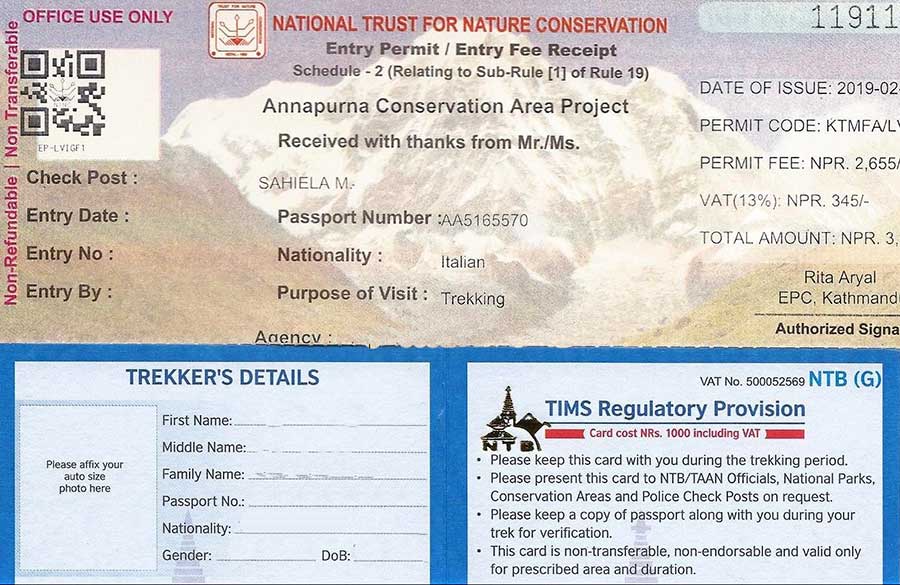Annapurna Base Camp Trek Difficulty
If you are dreaming to go for ABC trekking, it is obvious to know about Annapurna Base Camp Trek Difficulty. Accessing the risk factors helps with perfect preparation. The associated risk for going the Annapurna trek is relatively very lower than mountaineering or peak climbing. Most of the sections have fine trails with proper steps. Physically, you might have to encounter minimum dangers. Check the weather forecast, hire an experienced trek guide, following acclimatization rules, walk steadily, and consume healthy meals, intake enough liquid are the helpful factors to cope with the associated risks.
How to prepare for Annapurna Base Camp Trek Difficulty
Get the proper physical preparations
Annapurna Base Camp trek is an adventure high-altitude trek. It requires good physical condition to enjoy hiking. From the beginning, the trail includes stone stairs. Continuously climbing up and down the stairs gives exertion to your knees and foot muscles. Proper training to walk on a similar terrain helps to complete the trail without strains. The trail has thousands of steps special en route to Ghorepani and Poon Hill. Most of the part of the entire trail to Annapurna Base Camp is rocky with frequent ups and downs. It is a moderate trekking trail. However, requires training yourself before your trekking days.
Train on Stairs
Besides, jogging and running you need to train on steps up and down to prepare yourself for Annapurna Base Camp Trek. The terrain of the Annapurna region is steep and filled with steps. Furthermore, you should train yourself by carrying a small backpack for proper practice. Carrying your weighted backpack on while training up and downstairs, will help to tighten your thigh muscles and knee joints. A regular workout is good for your physical fitness.
How Difficult is it to Trek Annapurna Base Camp?
The adventure journey to Annapurna Base Camp is a stunning hike. It goes around some of the world’s highest peaks. The trekking trails lead you through the famous Annapurna Sanctuary. Hiking the trail gives you a world-class mountain trek with an amazing mountain view at a relatively lower altitude.
You will spend most of your time below 3,000m/ 10,000 feet from sea level. The terrain is challenging offering the view of terrace fields. You will be walking continuously for hours through the stone-paved stairs.
Is it tough for me? Will I be able to make it successful?
You can make it happen. The trek surely demands good preparedness. But many hikers with physical disabilities have completed the trek in past. The requirement is to go through proper training. You can develop your excellent leg strength, and balance by walking up and down long sets of stairs with a backpack on. Go through the training on a stair master with a weighted backpack at least four days a week. Incorporate a longer day hike with your weighted backpack to build your confidence. One must go for a couple of such hikes at least once a week before the trek. You should be ready for your adventure trip to Annapurna Base Camp.
You can leave a quick inquiry for any type of suggestion and guidelines. We will be happy to provide you with the free necessary trek information.
Getting the entry permits
You require to issue two types of permits to trek the Annapurna Base Camp trek. Since the entire trekking trail falls under the Annapurna Conservation Area, you should get your first entry permit from ACAP (Annapurna Conservation Area Project) counter in Kathmandu or Pokhara. Pay NRs 3000 per person for the permit. Similarly, get your TIMS (Trekkers Information Management System Card from the TAAN counter in Kathmandu or Pokhara beforehand of the trek commencement.
You can get your TIMS care for NRs 1000 (Packaged Trekker) and NRs 2000 (FIT). Packaged or Group trekkers are hikers who buy a trekking package from an authorized trekking company in Nepal. Both permits are valid for a single exit. Once you exit the check post, you should issue another for the next entry. The same entry permits work for all the trekking trails of the Annapurna Region. You should follow the same procedure to issue the permits for Ghandruk Trek, Ghorepani Poon Hill Trek, Mardi Himal Trekking,
What can I get to eat there? – Meal Options
Similar to the Mardi Himal Trekking route and surrounding trails of the Annapurna Region, Annapurna Base Camp Trek offers a variety of meal options in the menu. The Annapurna conservation area projects and the local management committee jointly monitor the food menus of the region. The lodges of the trail have a distinct menu for breakfast, lunch, and dinner. Trekking can choose to order as per the menu. Generally, it contains items of bread, potato, eggs, and seasonal vegetables. Most domestic tourists prefer to eat Dal-Bhat, a local Nepali dish twice a day. Since the Dal-Bhat is served with seasonable vegetable curry and pickles, it is a heavy diet for hard workers. Trekking guides and porters prefer to eat Dal-Bhat instead of other meals.

Best season to trek Annapurna Base Camp
March-June and September-December is the perfect time to visit Annapurna Base Camp Trek. Some people prefer to visit the region around the year.
The maximum altitude I will get while on the Annapurna Base camp trek
We reach 4,130m altitude in Annapurna base camp trekking. Most of the hikers combine the Annapurna Base Camp Trek with the Ghorepani Poon Hill Trekking. It adds up the charm in your itinerary with the amazing sunrise view experience from the top of Poon Hill. Furthermore, it will train the hikers to acclimatize up to the altitude of 3200meters with a stressful stair walk beforehand the Annapurna Circuit trek.
What happens when it’s a fast group and I am the slow plodder of this trek?
Generally, 5/6 hours of walking is the average walking of each day during the trek. If the trekker could not pace for average walking, Oriental Journeys will provide a separate guide. And even you can customize the itinerary as per your physical condition, comfort level, and time availability.
Annapurna Circuit vs Annapurna Base Camp
While looking at Annapurna Circuit Vs Annapurna Base Camp trekking trails, we should know the related facts. Annapurna Circuit Trek and Annapurna Base Camp Trek hears similar but in reality, are two different trekking trails. They lead two different areas of the Annapurna Mountain region. Annapurna Circuit trek is often called Round Annapurna trekking. It is a long journey with a challenging hike. The Annapurna Circuit trek is relatively longer and more scenic. The Annapurna Round Trekk passes through the wonderful Manang valley along the Marshyangdi river. Then crosses Thorong La and enters the Mustang Valley. Often mentioned as the zone of salvation, Mustang is one of the greatest pilgrimage sites of Hindus. It crosses an altitude of 5,420m/ 17,782 feet over Thorong-La pass. The trail circumambulates the Annapurna massive from Northersied making a circuit. It is one of the most popular hiking trails in the world.
However, the Annapurna Base Camp trek reaches 4,131m/ 13,553 feet as the only highest point of the trek. Both trails offer wonderful experiences to take on. The trail to Annapurna Base Camp is similarly scenic and most of its section lies relatively under a lower altitude. Very few trekkers experience altitude sickness-related issues during the ABC trek.
Both of the trails require good preparedness physically and mentally.
Annapurna circuit Vs Annapurna Base Camp Trek Difficulty
The Annapurna Circuit and Annapurna Base Camp trekking trails hear similar. But Annapurna Circuit is different from the Annapurna Base Camp trek. Annapurna Circuit rounds Annapurna Massif and needs to cross Thorang La Pass (5416m) since Annapurna Base camp ends at 4130m elevation.
Risk – Is it dangerous to trek Annapurna Base Camp?
No, the Annapurna Base Camp trek is not dangerous. However, trekking and adventure tour is all about physical fitness and preparedness (logistic, physical and mental). Therefore, the trek can be easily done by people aged from 10 to 75 years. Since the trekking trail does not have a straight up and straight down path, it can be done by the first-time traveler.
Avalanche is one of the biggest risk factors while on the ABC trek. There are certain sections before the Annapurna Base Camp, where it is hard to detect a possible avalanche. You need to be more careful especially when there is rainfall or snowfall in the Annapurna Region. In the past few years, some trekkers have lost their life due to avalanches.
Is it a long and hard walk?
The Annapurna Base camp trek can be done from 10 to 12 days depending on the itinerary and pace of your walking. The total distance of the Annapurna base camp trek is 115 km from Kathmandu. You will be walking from 10 to 20 km each day for this trek. During trekking, 5 to 7 hours of walking are the average day’s walking. However, above 3500m elevation, the times will be the same but you will only cover 8 to 9 km. However, all our itineraries can be customized as per the geographical and physical conditions of the individual participant.
Charging your electric gazets
The charging facilities will be available in some hotel receptions, however; we have to pay for this service. Please do not forget to bring two or three-pin travel adapters with you while coming in trekking.
Does this package include a guide?
A package trip to Annapurna Base Camp trek includes guides throughout the trip. A well-experienced guide will accompany you throughout the trek. He will help you in every situation. Typically, there are 5-8 people in a group. But once you book, the trip is guaranteed to depart. Besides a guide, a package trip includes porters to carry your luggage.
Team: Your guide for ABC Trek
Oriental Journeys will assist you with a local English-speaking guide who is a government-licensed holder. If you like, we may also assign guides who speak French, Spanish, Japanese, German, or any other language. However, you must pay an additional fee for them. His/her English may not be perfect, but it is enough for conversation. Expect him/her to provide information on the path, local culture, lifestyle, and terrain. They are locals who routinely visit the region. Use the assistance of guides if you want to try something new on the path.
Cost: additional expenses
Annapurna Base Camp Trek’s cost depends on your interests and spending habits. While you stay in Kathmandu, you can allocate per person $50 to &70 for lunch and dinner in Kathmandu. You can allocate approximately $ 300 to 350 per person to buy meals and drinks during the Annapurna Base Camp trek. Besides, your expenses, you require to issue Annapurna Conservation Area Permit and Trekkers’ Information Management System Card to trek the Annapurna Region.
For an Annapurna Base Camp package trek, your handling company (operator) manages your permits. Whereas a Free Individual traveler needs to pay US$40 equivalent Nepalese rupees for the permits. On top of it tipping your guide and porter is expected.
You can leave a quick inquiry for any type of suggestion and guidelines. We will be happy to provide you with the free necessary trek information.
A final Say
It is always better to access the risk and hazardous part of Annapurna Base Camp Difficulty during planning for the same trip. Trekkers should train themself for the rocky terrain hike and high altitude walk. Prepare with the necessary gear to keep yourself during the shared weather condition too. Physical preparedness including mental readiness is the most essential thing to accomplish any task. Adventure always needs courage with a thoughtful mind. Annapurna Base Camp Trek’s difficulty is not a hindrance for the hikers with strong determination and necessary preparation. We wish you the best of luck with your Annapurna Base Camp Expedition.

